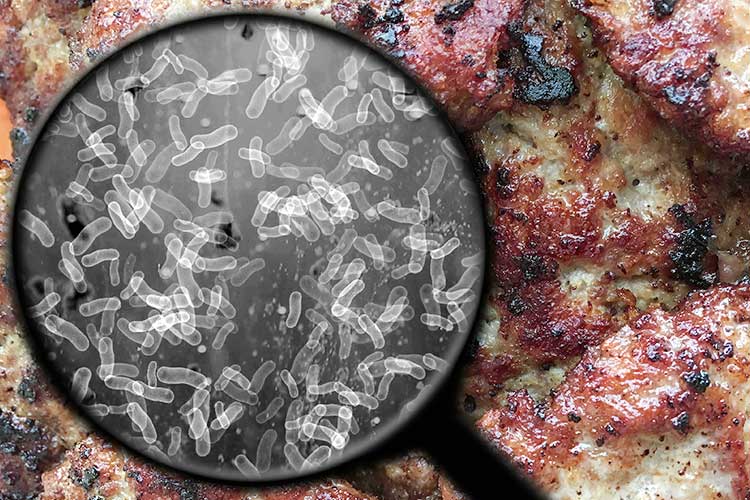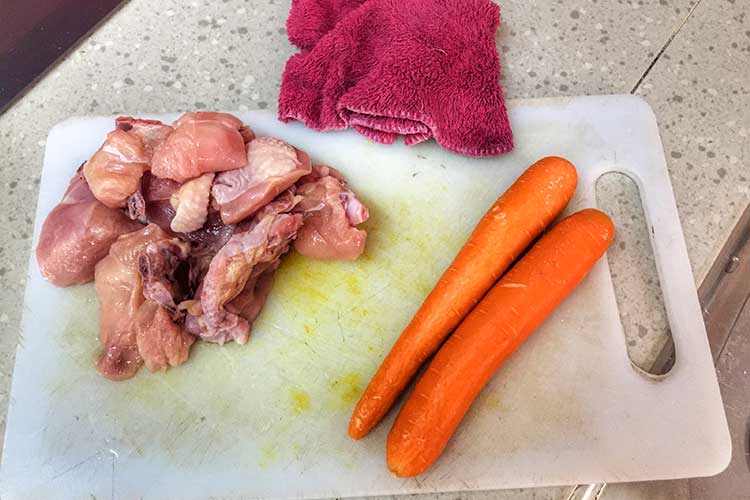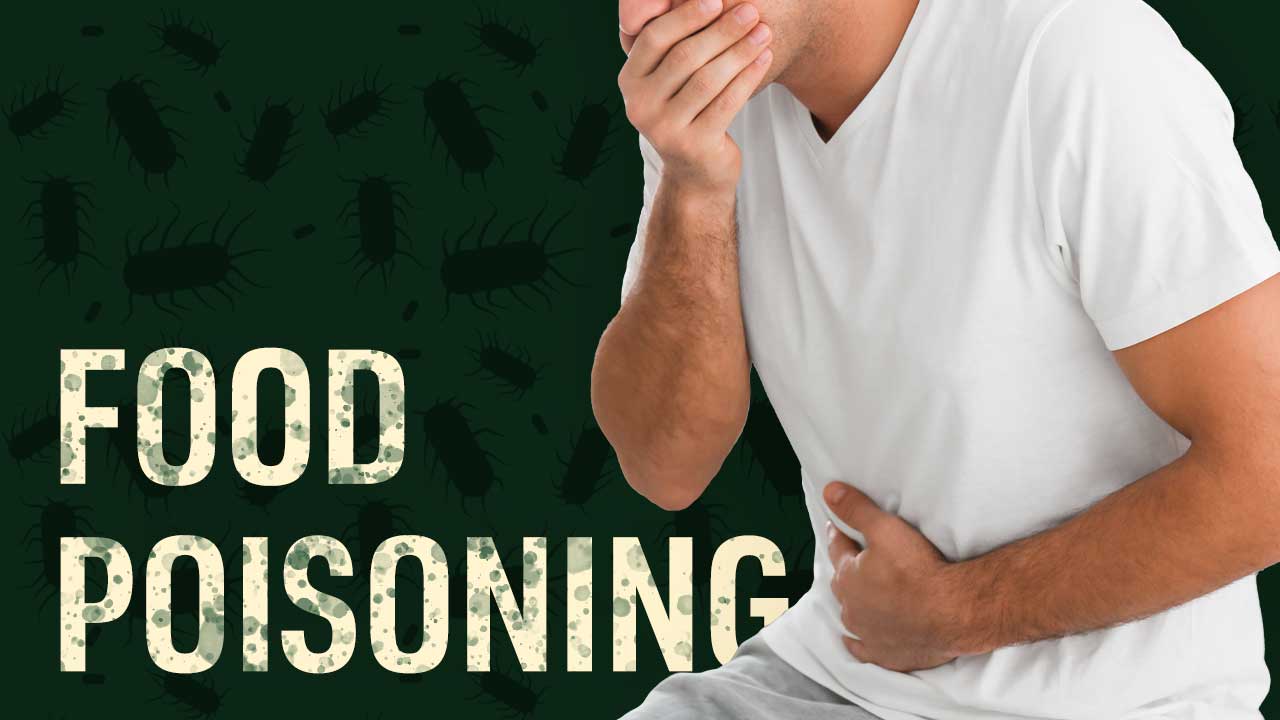Food poisoning is estimated to affect over 4.7 million Australians every year, resulting in about 47,900 hospitalisations and 38 deaths annually (FSANZ 2025a).
Despite these alarming statistics, many cases of food poisoning are actually easily preventable (FSANZ 2025).
What is Food Poisoning?
Foodborne illness, colloquially known as food poisoning, is an umbrella term describing the range of illnesses that can occur after ingesting contaminated foods and drinks (NSW Food Authority 2025).
Food poisoning occurs when an individual consumes food containing harmful viruses, bacteria or toxins and consequently becomes unwell (Healthdirect 2023).
Despite being extremely common, food poisoning has the potential to cause serious illness and even death, especially among vulnerable populations such as older adults, young children, pregnant people and those with pre-existing chronic conditions (VIC DoH 2024).
What Causes Food Poisoning?

Pathogens and toxins are inherently present in the natural environment. Bacteria, for example, can be found in soil, animals and humans - even those who are healthy. Products such as meats and vegetables often naturally contain bacteria that are harmless in small amounts but can become more dangerous if left to multiply (VIC DoH 2024).
Certain pathogens and toxins are more likely to cause illness than others. This is because they:
- May be hard to detect
- Are easily transferred between humans, animals, pests and raw produce
- Grow rapidly in ambient room temperatures or water (e.g. Bacillus cereus)
- Can potentially survive or regenerate even after control steps such as cooking have been taken.
(WHO & FAO 2021; EFSA Panel on Biological Hazards (BIOHAZ) et al. 2024)
Pathogens and toxins that commonly cause food poisoning include:
- Bacillus cereus
- Campylobacter
- Clostridium perfringens
- Clostridium botulinum
- Hepatitis A and E viruses
- Listeria
- Norovirus
- Rotavirus
- Escherichia coli (E. Coli)
- Salmonella
- Seafood toxins
- Shigella
- Staphylococcus aureus
- Yersinia.
(FSANZ 2025b; NSW Food Authority 2025)
There are certain foods that are more likely to become contaminated because they either contain pathogens that could become dangerous if left to multiply or provide an ideal environment for harmful pathogens to grow and thrive. These potentially hazardous foods include:
- Meat and meat-containing foods
- Smallgoods
- Dairy products
- Seafood
- Processed or cut fruits and vegetables, such as pre-prepared salads
- Foods containing protein-rich ingredients like eggs, beans and nuts
- Rice and pasta
- Sprouted seeds, e.g. alfalfa and bean sprouts
- Food that contains any of the above ingredients, such as sandwiches.
(SA Health 2024; NSW Food Authority 2025)
Certain sources of food poisoning, such as poisonous mushrooms, are dangerous to ingest regardless of how they are prepared (Healthdirect 2023).
It’s important to remember that food doesn’t necessarily need to smell, look or taste bad to be contaminated. Most cases of food poisoning are caused by food that seems perfectly inconspicuous. This is why taking appropriate food safety measures is crucial in preventing illness (NSW Food Authority 2020).
How Does Food Become Contaminated?

The way in which food poisoning occurs can be described by the ‘food poisoning chain’:
- Pathogens or toxins are present in the food.
- The pathogens or toxins are provided with the right conditions required to grow: temperature, moisture and a food source.
- The pathogens or toxins are given adequate time to grow and multiply.
If any of the links in this chain are broken, food poisoning can be prevented (VIC DoH 2024).
Examples of breaking the chain include ensuring food is cooked at a high enough temperature to kill pathogens, storing food at a safe temperature and eating food as soon as it has been cooked.
Ways in which food can become contaminated by harmful pathogens and toxins include:
- Poor food preparation (e.g. undercooking meat)
- Food being handled without prior handwashing
- Food being handled by an unwell person
- Food being touched by pets, flies, insects etc.
- Cross-contamination (e.g. using a chopping board for raw meat that is then used for cooked meat without being washed in between)
- Unsafe food storage (e.g. storing food at temperatures that allow bacteria to grow and multiply)
- Fruit, vegetables and eggs coming into contact with animal manure
- Letting food progress past its ‘use-by’ date.
(Healthy WA 2018; NSW Food Authority 2025)
Symptoms of Food Poisoning
Food poisoning typically causes symptoms such as:
(Better Health Channel 2024; Healthdirect 2023)
The most common complication of food poisoning is dehydration, which can occur if the individual loses more fluids than they can replace due to vomiting and diarrhoea. In severe cases, dehydration may require admission to hospital and intravenous fluid replacement (Mayo Clinic 2024).
Depending on the cause of the food poisoning, the individual might also be at risk of other potentially severe complications. For example:
- Listeria infection may lead to a miscarriage or pregnancy or birth complications
- Listeria infection may result in meningitis
- E. coli infection may cause haemolytic uraemic syndrome, which can lead to kidney failure.
(Mayo Clinic 2024; Better Health Channel 2024)
The onset of symptoms depends on the underlying cause of the food poisoning. For example, Salmonella can cause symptoms after as little as six hours, while Listeria infection can take up to 10 weeks to cause illness (Healthdirect 2023).
For this reason, it can’t be assumed that food poisoning is caused by the most recent food consumed (NSW Food Authority 2020).

Treatment for Food Poisoning
Most cases of food poisoning resolve on their own after one to two days, but certain infections (e.g. E. coli, hepatitis A) may persist for longer (Food Safety Information Council 2022).
Mild cases can typically be managed at home using strategies such as:
- Sucking on ice chips for fluid intake
- Using an oral rehydration solution to replenish lost fluids
- Easing back into a normal diet and routine.
(Healthdirect 2023)
When to Escalate Care
While many people who experience food poisoning don’t require medical intervention, it can be a serious illness. Signs that care should be escalated include:
- High-risk patient (e.g. people who are pregnant, elderly, very young or immunocompromised)
- Symptoms that have lasted for more than three days, or are extremely severe
- Signs of severe dehydration (e.g. inability to keep fluids down, little or no urine output, weight loss, fatigue, extreme thirst)
- Blood or mucus is present in vomit or diarrhoea
- Fever of over 38.6°C
- Blurry vision, muscle weakness or tingling in arms.
(Healthdirect 2023; Food Safety Information Council 2019)
Preventing Food Poisoning
For comprehensive guidance on how to prevent food poisoning, see Ausmed’s Training Module on Food Safety in Residential Aged Care.
Test Your Knowledge
Question 1 of 3
Which one of the following is a potentially hazardous food?
Topics
Further your knowledge
References
- Better Health Channel 2024, Food Poisoning - Prevention, Victoria State Government, viewed 25 July 2025, https://www.betterhealth.vic.gov.au/health/healthyliving/food-poisoning-prevention
- EFSA Panel on Biological Hazards (BIOHAZ), Koutsoumanis, K, Allende, A et al. 2024, ‘Persistence of Microbiological Hazards in Food and Feed Production and Processing Environments’, EFSA Journal, vol. 22, no. 1, viewed 25 July 2025, https://efsa.onlinelibrary.wiley.com/doi/full/10.2903/j.efsa.2024.8521
- Food Standards Australia New Zealand 2025a, Food Safety Culture, Australian Government, viewed 25 July 2025, https://www.foodstandards.gov.au/business/food-safety-culture
- Food Standards Australia New Zealand 2025b, Bacteria, Viruses and Toxins That Cause Foodborne Illness, Australian Government, viewed 25 July 2025, https://www.foodstandards.gov.au/consumer/prevention-of-foodborne-illness/bacteria-foodborne-illness
- Food Safety Information Council 2019, Is it Food Poisoning?, Food Safety Information Council, viewed 25 July 2025, https://foodsafety.asn.au/topic/is-it-food-poisoning/
- Food Safety Information Council 2022, Food Safety Learning Centre, Food Safety Information Council, viewed 25 July 2025, https://foodsafety.asn.au/topic/food-safety-learning-centre/
- Healthdirect 2023, Food Poisoning, Australian Government, viewed 25 July 2025, https://www.healthdirect.gov.au/food-poisoning
- Healthy WA 2018, Food Poisoning, Government of Western Australia, viewed 25 July 2025, https://www.healthywa.wa.gov.au/Articles/F_I/Food-poisoning
- Mayo Clinic 2024, Food Poisoning, Mayo Clinic, viewed 25 July 2025, https://www.mayoclinic.org/diseases-conditions/food-poisoning/symptoms-causes/syc-20356230
- NSW Food Authority 2020, Fact or Fiction, New South Wales Government, viewed 25 July 2025, https://www.foodauthority.nsw.gov.au/consumer/food-poisoning/fact-or-fiction
- NSW Food Authority 2025, Food Poisoning, New South Wales Government, viewed 25 July 2025, https://www.foodauthority.nsw.gov.au/consumer/food-poisoning
- SA Health 2024, Food Processing and Potentially Hazardous Foods, Government of South Australia, viewed 25 July 2025, https://www.sahealth.sa.gov.au/wps/wcm/connect/public+content/sa+health+internet/public+health/food+safety+for+businesses/food+safety+issues/food+processing+and+potentially+hazardous+foods
- Victoria Department of Health 2024, Preventing Food Poisoning, Victoria State Government, viewed 25 July 2025, https://www.health.vic.gov.au/food-safety/preventing-food-poisoning
- World Health Organisation & Food and Agriculture Organization of the United Nations 2021, Microbiological Risk Assessment: Guidance for Food, WHO, viewed 25 July 2025, https://www.who.int/publications/i/item/9789240024892
 New
New 

